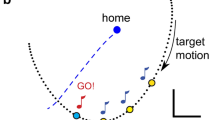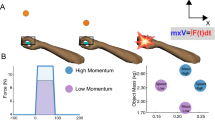Abstract
The act of puncturing a surface with a hand-held tool is a ubiquitous but complex motor behavior that requires precise force control to avoid potentially severe consequences. We present a detailed model of puncture over a time course of approximately 1,000 ms, which is fit to kinematic data from individual punctures, obtained via a simulation with high-fidelity force feedback. The model describes puncture as proceeding from purely physically determined interactions between the surface and tool, through decline of force due to biomechanical viscosity, to cortically mediated voluntary control. When fit to the data, it yields parameters for the inertial mass of the tool/person coupling, time characteristic of force decline, onset of active braking, stopping time and distance, and late oscillatory behavior, all of which the analysis relates to physical variables manipulated in the simulation. While the present data characterize distinct phases of motor performance in a group of healthy young adults, the approach could potentially be extended to quantify the performance of individuals from other populations, e.g., with sensory–motor impairments. Applications to surgical force control devices are also considered.







Similar content being viewed by others
Notes
Note that our model does not assume an underlying mass–spring system, as it applies to active braking in response to a sudden release of resisting force while moving. Fitting a mass/spring model in our task would require an additional parameter beyond the biomechanical stiffness, namely the zero point of the system. Instead, we begin with the impulse force from membrane puncture and describe its passive decline as exponential. We also evaluated linear force decay, which was obviously inferior in fit to the data over its entire time course.
These values are not equally spaced because of sensitivity constraints on the low end and stability constraints on the high end. Preliminary testing with a lower value, though above the force threshold previously found for this device with a similar manipulandum and normal forces (approximately 0.16 ± 0.04 N), showed that subjects often did not detect the membrane. Although the lowest value used here is well above threshold, the data suggest that subjects still failed to detect the weakest membrane on some trials.
References
Aron AR, Poldrack RA (2006) Cortical and subcortical contributions to stop signal response inhibition: role of the subthalamic nucleus. J Neurosci 26:424–2433
Chambers CD, Bellgrove MA, Stokes MG, Henderson TR, Garavan H, Robertson IH, Morris AP, Mattingley JB (2006) Executive “brake failure” following deactivation of human frontal lobe. J Cogn Neurosci 18:444–455
Di Domizio J, Keir PJ (2010) Forearm posture and grip effects during push and pull tasks. Ergonomics 53:336–343
Feldman AG, Levin MF (2009) The equilibrium-point hypothesis—past, present, and future. In: Sternad D (ed) Progress in motor control. Springer, New York, pp 699–726
Fitts PM (1954) The information capacity of the human motor system in controlling the amplitude of movement. J Exp Psychol 47:381–391
Fleming I, Balicki M, Koo J, Iordachita I, Mitchell B, Handa J, Hager G, Taylor R (2008) Cooperative robot assistant for retinal microsurgery. In: MICCAI 2008, Part II, LNCS, vol 5242, pp 543–550
Franklin DW, Wolpert DM (2011) Computational mechanisms of sensorimotor control. Neuron 72:425–442
Fu MJ, Çavuşoğlu MC (2012) Human arm-and-hand dynamics model with variability analyses for a stylus-based haptic interface. IEEE Trans Syst Man Cybern Part B 42:1633–1644
Fung YC (1967) Elasticity of soft tissues in simple elongation. Am J Physiol 213:1532–1544
Gupta PK, Jensen PS, de Juan E Jr (1999) Surgical forces and tactile perception during retinal microsurgery. Medical image computing and computer-assisted intervention. In: Lecture notes in computer science, vol 1679, pp 1218–1225
Hollis RL, Salcudean SE (1993) Lorentz levitation technology: a new approach to fine motion robotics, teleoperation, haptic interfaces, and vibration isolation. In: Proceedings of 5th international symposium on robotics research, Hidden Valley, PA, 1–4 Oct 1993
Jagtap AD, Riviere CN (2004) Applied force during vitreoretinal microsurgery with handheld instruments. In: Proceedings of the 26th annual international conference of the IEEE engineering in Medicine and Biology Society, San Francisco, CA, USA, 1–5 Sept 2004
Jaric S, Gottlieb GL, Latash ML, Corcos DM (1998) Changes in the symmetry of rapid movements: effects of velocity and viscosity. Exp Brain Res 120:52–60
Jeannerod M (1984) The timing of natural prehension movements. J Motor Behav 16:235–254
Johansson RS, Flanagan JR (2009) Coding and use of tactile signals from the fingertips in object manipulation tasks. Nat Rev Neurosci 10:345–359
Kisiel-Sajewica K, Jaskolski A, Jaskolska A (2005) Current knowledge in studies on relaxation from voluntary contraction. Hum Mov 6:136–148
Lacquaniti F, Terzuolo C, Viviani P (1983) The law relating the kinematic and figural aspects of drawing movements. Acta Psychol 54:115–130
Lipps DB, Galecki AT, Ashton-Miller JA (2011) On the implications of a sex difference in the reaction times of sprinters at the Beijing Olympics. PLoS ONE 6:e26141. doi:101371/journalpone0026141
Meyer DE, Abrams RA, Kornblum S, Wright CE, Smith JEK (1988) Optimality in human motor performance: ideal control of rapid aimed movements. Psychol Rev 95:340–370
Milanovic S, Blesic S, Jaric S (2000) Changes in movement variables associated with transient overshoot of the final position. J Motor Behav 32:115–120
Milner-Brown HS, Stein RB, Yemm R (1973) The contractile properties of human motor units during voluntary isometric contractions. J Physiol 228:285–306
Mussa-Ivaldi FA, Hogan N, Bizzi E (1985) Neural, mechanical and geometric factors subserving arm in humans. J Neurosci 5:2732–2743
Nambu A, Tokuno H, Takada M (2002) Functional significance of the cortico-subthalamo-pallidal ‘hyperdirect’ pathway. Neurosci Res 43:111–117
Neubert FX, Mars RB, Buch ER, Olivier E, Rushworth MF (2010) Cortical and subcortical interactions during action reprogramming and their related white matter pathways. Proc Natl Acad Sci 107:13240–13245
Prattichizzo D, Pacchierotti C, Rosatti G (2012) Cutaneous force feedback as a sensory subtraction technique in haptics. IEEE Trans Haptics 5:289–300
Rosenbaum DA, Loukopoulos LD, Meulenbroek RGJ, Vaughan J, Engelbrecht SE (1995) Planning reaches by evaluating stored postures. Psychol Rev 102:28–67
Salcudean SE, Yan J (1994) Towards a force-reflecting motion-scaling system for micro-surgery. In: Proceedings of IEEE international conference on robotics and automation, San Diego, CA, vol 3, pp 2296–2301
Sarver JJ, Robinson PS, Elliott DM (2003) Methods for quasi-linear viscoelastic modeling of soft tissue: application to incremental stress-relaxation experiments. Trans ASME 125:754–758
Shadmehr R, Krakauer JW (2008) A computational neuroanatomy for motor control. Exp Brain Res 185:359–381
Sommer MA, Wurtz RH (2008) Brain circuits for the internal monitoring of movements. Annu Rev Neurosci 31:317–338
Stetten G, Wu B, Klatzky R, Galeotti J, Siegel M, Lee R, Hollis R (2011) Hand-held force magnifier for surgical instruments. In: Taylor R (ed) Lecture notes in computer science, vol 6689, pp 90–100
Taylor R, Bames A, Kumar R, Gupta P, Wang Z, Jensen P, Whitcomb L, deJuan E, Stoianovici D, Kavoussi L (1999) A steady-hand robotic system for microsurgical augmentation. In: Delp SL, DiGoia M, Jaramaz B (eds) Lecture notes in computer science, vol 1679, pp 1031–1041
Tee KP, Burdet E, Chew CM, Milner TE (2004) A model of force and impedance in human arm movements stiffness is linearly related to the magnitude of the joint torque and increased to compensate for environment instability. Biol Cybern 90:368–375
Tsuji T, Takeda Y, Tanaka Y (2004) Analysis of mechanical impedance in human arm movements using a virtual tennis system. Biol Cybern 91:295–305
Weiss EJ, Flanders M (2011) Somatosensory comparison during haptic tracing. Cereb Cortex 21:425–434
Woodworth RS, Schlossberg H (1960) Experimental psychology: revised edition. Henry Holt, New York
Zandbelt BB, Bloemendaal M, Hoogendam JM, Kahn RS, Vink M (2013) Transcranial magnetic stimulation and functional MRI reveal cortical and subcortical interactions during stop-signal response inhibition. J Cogn Neurosci 25:157–174
Acknowledgments
The authors acknowledge support from the National Science Foundation (IIS0964100) and National Institute of Mental Health (EY021641). We thank Ralph Hollis for the use of the haptic device.
Author information
Authors and Affiliations
Corresponding author
Rights and permissions
About this article
Cite this article
Klatzky, R.L., Gershon, P., Shivaprabhu, V. et al. A model of motor performance during surface penetration: from physics to voluntary control. Exp Brain Res 230, 251–260 (2013). https://doi.org/10.1007/s00221-013-3648-4
Received:
Accepted:
Published:
Issue Date:
DOI: https://doi.org/10.1007/s00221-013-3648-4




